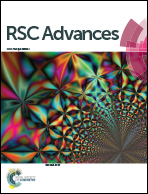Exploring the interaction of cisplatin with β2-microglobulin: new insights into a chemotherapeutic drug†
Abstract
Cisplatin is one of the most widely used anticancer platinum drugs and the interactions between cisplatin and proteins are deemed to be associated with its severe side-effects and drug resistance generated in the chemotherapy process. Here, the interaction of cisplatin with β2-microglobulin was investigated using electrospray ionization Fourier transform ion cyclotron resonance mass spectrometry (ESI FTICR MS). High resolution MS data revealed that β2-microglobulin (β2M) can quickly react with cisplatin in 5 mM NH4OAc aqueous solution (pH 7.0) and up to five platinated complexes were bound to β2M in 24 h. The primary monoadduct was determined to be β2-microglobulin–Pt(NH3). Besides, the oxidation of Met99 to methionine sulfoxide decreased the reaction velocity of β2M and cisplatin. Four binding sites for cisplatin to β2M have been identified using FTICR MS combined with a bottom-up approach without complex liquid chromatography separation. Met99 and His51 were identified as the main binding sites. Besides, His84 and His31 were the other two binding sites. What's more, the platination of β2M disrupts the conformation of the protein, and coordination of different platinum species induced different conformation changes of β2M. Interestingly, a Pt(II) bridged dimer of β2M was observed under physiological conditions. This work highlights the ability of high resolution mass spectrometry to study the interactions between β2M and cisplatin, but also provides unique insights into the mechanism of side-effects of cisplatin at a molecular level.


 Please wait while we load your content...
Please wait while we load your content...